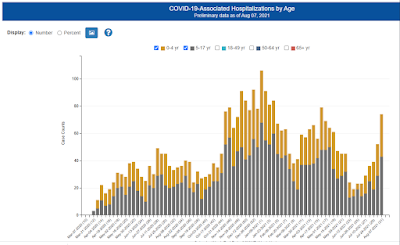There's been a lot of coverage lately about kids getting COVID, in particular due to the fact school is about to start and kids under twelve are the main group of people who are not able to get vaccinated at this time. Last week I took a look at data on deaths of children, and there the data shows that we are not in fact seeing an unusual number of children dying. Indeed, since the pandemic started, child deaths have been lower than on average.
But of course, you can still have a pretty bad time of it without dying, so I wanted to see if it was possible to see what the risks of children getting seriously sick with COVID are. The best that I was able to do in that regard is to look at hospitalization data from the CDC. This tells us how many children under 18 with COVID are admitted to hospitals, though it does not tell us how sick they are or what lasting effects may stay with them. Still, I think any parent would agree, any day when you have to take your kid to the hospital is a bad day, so I think it's a pretty reasonable way to look at the risk of serious COVID.
The short takeaway
Kids are still the least likely to be hospitalized with COVID (about 1/10th the average rate for Americans) but kids are being hospitalized at the highest rates of the pandemic: 263 per day last week
0-17: 263 per day now, 219 at Jan peak18-29: 694 now, 608 at Jan peak30-39: 1,113 now, 883 at Jan peak40-49: 1,422 now, 1,265 at Jan peak
So while overall hospitalizations are down compared to the January peak, that's entirely driven by older people who (with their higher vaccination rates) are not getting COVID as much or as badly. Among young people, who are less likely to have bad cases of COVID, the vaccination rate is lower and the number of hospitalizations is up.
There's variation by region in all this. The southern regions of the country (CDC Region 6 which includes Texas and CDC Region 4 which includes Florida) are seeing hospitalizations of children up more versus the winter than the rest of the country, with Region 6 seeing kids hospitalized at 1.5x the rate they were in January and Region 4 seeing them hospitalized at 1.8 the January rate. Other parts of the country are seeing fewer child hospitalizations than the winter peak. In Region 5 (which includes my home state of Ohio) child hospitalizations are at less than half the winter rate.So in conclusion: Compared to older people, kids are less likely to have COVID bad enough to be admitted to the hospital, even though no kids under 12 are vaccinated. But kids are a larger percentage of hospital admissions than before. There's some hype to the discussion of kids being hospitalized with COVID, in that it's still quite rate for kids to get it that badly compared to adults. But when there's more COVID around, more kids will get it.
You can look at the data yourself here. One note, if you explore the data yourself, do not use the COVID-NET data set to try to get national numbers. The way it's labeled, you may not realize it at first, but that's data based on a sample of ten large counties around the nation, and it doesn't include FL or TX, so it's not very representative right now. This is what the COVID net sample report looks like. Don't be fooled (I was briefly and embarrassingly.)






2 comments:
Was looking for these numbers earlier. Thank you.
The southern regions of the country (CDC Region 6 which includes Texas and CDC Region 4 which includes Florida) are seeing hospitalizations of children up more versus the winter than the rest of the country, with Region 6 seeing kids hospitalized at 1.5x the rate they were in January and Region 4 seeing them hospitalized at 1.8 the January rate. Other parts of the country are seeing fewer child hospitalizations than the winter peak. In Region 5 (which includes my home state of Ohio) child hospitalizations are at less than half the winter rate.
Saw someone point out that this time of year is when the heat is worse in the south so people head indoors. (Air conditioning!) And indoors is where these things spread worse. As comparison, look at historical flu numbers which would also see summer spikes in the south.
Post a Comment